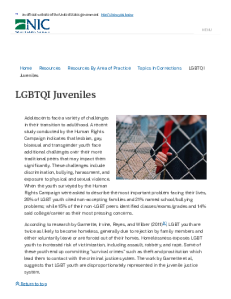
National Institute of Corrections
Keywords: Juvenile Justice; Research; Secure Facilities
Adolescents face a variety of challenges in their transition to adulthood. A recent study conducted by the Human Rights Campaign indicates that lesbian, gay, bisexual and transgender youth face additional challenges over their more traditional peers that may impact them significantly. These challenges include discrimination, bullying, harassment, and exposure to physical and sexual violence. When the youth surveyed by the Human Rights Campaign were asked to describe the most important problem facing their lives, 26% of LGBT youth cited non-accepting families and 21% named school/bullying problems; while 15% of their non-LGBT peers identified classes/exams/grades and 14% said college/career as their most pressing concerns.
According to research by Garnette, Irvine, Reyes, and Wilber (2011), LGBT youth are twice as likely to become homeless, generally due to rejection by family members and either voluntarily leave or are forced out of their homes. Homelessness exposes LGBT youth to increased risk of victimization, including assault, robbery, and rape. Some of these youth end up committing “survival crimes” such as theft and prostitution which lead them to contact with the criminal justice system. The work by Garnette et al, suggests that LGBT youth are disproportionately represented in the juvenile justice system. This page compiles a number of resources specific to justice involved LGBTQI juveniles. [Summary adapted from resource.]
File : pdf with 0.14 MB in size
LGBTQI Juveniles